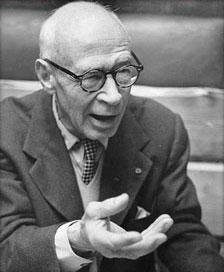It is the dexterity of the master, the visionary clutch which holds firm and secure its prey without ruffling a feather.
There are moments when he gives you the impression of being seated on another planet making his inventory of the world. Conjunctions are recorded such as no astronomer has noted. I am thinking now of a picture which he calls “Almost Full Moon.” The almost is characteristic of Reichel.
This almost full is not the almost full with which we are familiar. It is the almost-full-moon which a man would see from Mars, let us say. For when it will be full, this moon, it will throw a green, spectral light reflected from a planet just bursting into life.
This is a moon which has somehow strayed from its orbit. It belongs to a night studded with strange configurations and it hangs there taut as an anchor in an ocean of pitchblende.
So finely balanced is it in this unfamiliar sky that the addition of a thread would destroy its equilibrium. This is one of the moons which the poets are constantly charting and concerning which, fortunately, there is no scientific knowledge.
Under these new moons the destiny of the race will one day be determined. They are the anarchic moons which swim in the latent protoplasm of the race, which bring about baffling disturbances, angoisse, hallucinations.
Everything that happens now and has been happening for the last twenty thousand years or so is put in the balance against this weird, prophetic cusp of a moon which is traveling towards its optimum.
The moon and the sea! What cold, clean attractions obsess him! That warm, cosy fire out of which men build their petty emotions seems almost unknown to Reichel. He inhabits the depths, of ocean and of sky. Only in the depths is he content and in his element.
Once he described to me a Medusa he had seen in the waters of Spain. It came swimming towards him like a sea-organ playing a mysterious oceanic music. I thought, as he was describing the Medusa, of another painting for which he could not find words.
I saw him make the motion with his arms, that helpless, fluttering stammer of the man who has not yet named everything. He was almost on the point of describing it when suddenly he stopped, as if paralyzed by the dread of naming it.
But while he was stuttering and stammering I heard the music playing; I knew that the old woman with the white hair was only another creature from the depths, a Medusa in female guise who was playing for him the music of eternal sorrow.
I knew that she was the woman who inhabited “The Haunted House” where in hot somber tones the little white bird is perched, warbling the pre-ideological language unknown to man. I knew that she was there in the “Remembrance of a Stained Glass Window,” the being which inhabits the window, revealing herself in silence only to those who have opened their hearts.
I knew that she was in the wall on which he had painted a verse of Rilke’s, this gloomy, desolate wall over which a smothered sun casts a wan ray of light. I knew that what he could not name was in everything, like his black sorrow, and that he had chosen a language as fluid as music in order not to be broken on the sharp spokes of the intellect.
In everything he does color is the predominant note. By the choice and blend of his tones you know that he is a musician, that he is preoccupied with what is unseizable and untranslatable. His colors are like the dark melodies of César Franck. They are all weighted with black, a live black, like the heart of chaos itself.
This black might also be said to correspond to a kind of beneficent ignorance which permits him to resuscitate the powers of magic. Everything he portrays has a symbolic and contagious quality: the subject is but the means for conveying a significance which is deeper than form or language.
When I think, for example, of the picture which he calls “The Holy Place,” one of his strikingly unobtrusive subjects, I have to fall back on the word enigmatic. There is nothing in this work which bears resemblance to other holy places that we know of.
It is made up of entirely new elements which through form and color suggest all that is called up by the title. And yet, by some strange alchemy, this little canvas, which might also have been called “Urim and Thummim,” revives the memory of that which was lost to the Jews upon the destruction of the Holy Temple.
It suggests the fact that in the consciousness of the race nothing which is sacred has been lost, that on the contrary it is we who are lost and vainly seeking, and that we shall go on vainly seeking until we learn to see with other eyes.
In this black out of which his rich colors are born there is not only the transcendental but the despotic. His black is not oppressive, but profound, producing a fruitful disquietude. It gives one to believe that there is no rock bottom any more than there is eternal truth.
Nor even God, in the sense of the Absolute, for to create God one would first have to describe a circle. No, there is no God in these paintings, unless it be Reichel himself.
There is no need for a God because it is all one creative substance born out of darkness and relapsing into darkness again.
The end
